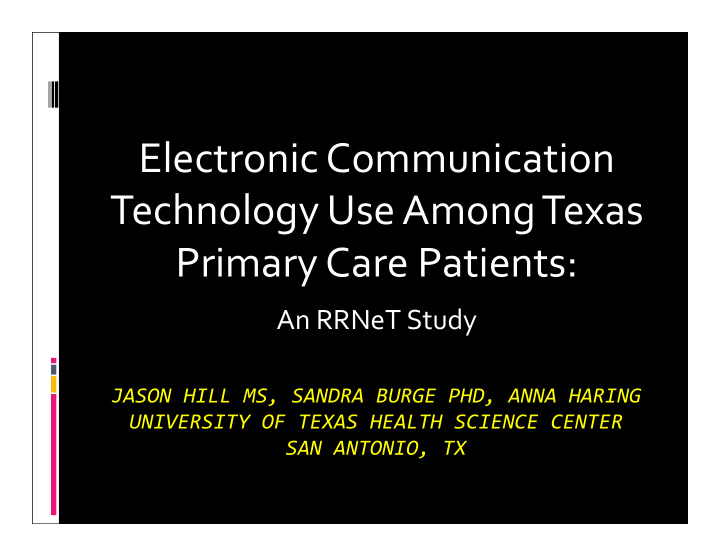



Electronic Communication Technology Use Among Texas Primary Care Patients: An RRNeT Study JASON HILL MS, SANDRA BURGE PHD, ANNA HARING UNIVERSITY OF TEXAS HEALTH SCIENCE CENTER SAN ANTONIO, TX
Question: I wonder how many of our patients have cell phones? computers? internet service?
RRNeT: Residency Research Network of Texas
Americans’ Access to Electronic Communication The Pew Research Center (2011) described access to cell phones, computers and Internet. 88% of Americans have a cell phone 57% have a laptop 78% use the internet Older people are less likely to use the internet than younger people (41% versus 94%) Low income people are less likely to use the internet than high income people (62% versus 97%)
Patient Centered Medical Home Part of being “patient ‐ centered” means increasing access to health care, including electronic access to health information. Practices are rewarded for: Using e ‐ mail systems and text messaging to communicate health information to patients. Creating web portals whereby patients can communicate with physicians in real time. Creating websites where health information can be communicated to patients.
What Do Patients Want? What Can Patients Use? Are our low ‐ income minority patients ‘connected’? Do they want to use electronic devices for communicating health information?
Study Purpose To evaluate primary care patients’ access to, use of, and preferences for cell phones and computers for communicating health information To examine differences in access, use, and preferences based on gender, age, race/ ethnicity, and insurance status
METHODS
Methods Subject Recruitment Summer 2011 During 5 to 8 clinic half ‐ day sessions per week, Medical Student research assistants randomly selected a physician, And invited all his/ her adult patients to complete a survey This study had IRB approval from 9 hospitals & 2 universities
Methods Measurement 1 page anonymous survey Patient demographics Access to telephones, cell phones, home computers, internet Use of electronic devices Preferences for sending and receiving health information via electronic modalities.
Methods Analysis Chi square tests examined group differences in technology access, use and preferences Groups were defined by gender, age, insurance status, and race/ethnicity. Health insurance status was considered an estimate for socioeconomic status
RESULTS
533 Adult Patients Ethnicity/ 4% Gender Race 13% 33% 52% 31% 67% Latino Caucasian Males Females African American Other
533 Adult Patients Insurance Type Age 5% 5% 27% 21% 26% 20% 52% 21% 23% Private Medicare Young Adults [21 ‐ 39 yrs] Medicaid County Plan Middle Age [40 ‐ 64 yrs] Self Pay Unknown Seniors [65 + yrs]
Basic Access 97% have a telephone 84% have a cell phone 53% use texting 38% have month ‐ to ‐ month contracts 18% changed phone number in past year 62% own a computer Few differences between women and men Men more likely to have cell phone Men more likely to own a computer
Access 0 100 200 300 400 500 600 533 Subjects 510 17 Own a Phone yes 440 93 no Own a Cell Phone 200 240 Monthly Contract 325 208 Computer at Home
Use 0 100 200 300 400 500 440 Own Cell Phone 280 160 Use Texting 325 Computer at Home yes 259 66 Use Internet no 253 72 Use Email 167 158 Use Facebook 131 194 View YouTube
Preferences 0 100 200 300 400 500 Total Sample 533 send health info by text 107 174 receive health info by text 100 181 send health info by email 200 53 receive health info by email 189 64 send health info by internet 67 192 receive health info by internet 72 187 yes no
Age Differences in Access & Use 100% 80% 60% Young Adults Middle Age 40% Seniors 20% 0% Cell Texting Computer Internet Email Facebook Phone Search All comparisons, p=.000
Insurance Status by Access & Use 100% 80% 60% Private Medicare 40% Medicaid Other 20% 0% Cell Phone Texting Computer Internet Email Facebook Search All comparisons, p=.000
Race/Ethnicity by Access & Use 100% ns 80% p=.000 p=.000 p=.024 p=.000 60% Latinos p=.008 40% Caucasians African Amer 20% 0% Cell Texting Computer Internet Email Facebook Phone Search
Age Differences in Preferences 100% Would you like sending/ receiving your health information by… ? 80% 60% Young Adults Middle Age 40% Seniors 20% 0% send by receive by send by receive by send by receive by text text email email internet internet All comparisons, p ≤ .005
Insurance Status by Preferences 100% Would you like sending/ receiving your health information by… ? 80% 60% Private Medicare 40% Medicaid ns Other 20% 0% send by receive by send by receive by send by receive by text text email email internet internet Most comparisons, p ≤ .005
Race/Ethnicity by Preferences 100% Would you like sending/ receiving your health information by… ? 80% 60% p=.006 p=.000 Latinos 40% Caucasians ns African Amer ns 20% ns ns 0% send by receive by send by receive by send by receive by text text email email internet internet
CONCLUSIONS
Conclusions Almost everybody has a phone (97%) The people with greatest access to and use of electronic communication technology are: Younger Caucasian With private health insurance
Conclusions Our patients are less likely to have internet access, compared to the Pew Research Study (50% versus 78%) Few patients want to send or receive health information electronically E ‐ mail was most acceptable mode 36% ‐ 38%
Conclusions For many, “high touch” communication is preferred to “high ‐ tech” To be patient ‐ centered, practices need to ASK PATIENTS about their preferences for: Health care access Communication of health information
High Touch!
Recommend
More recommend